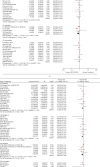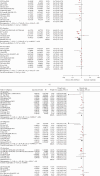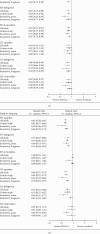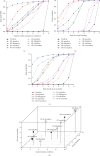Effectiveness and Safety of Dose-Specific DOACs in Patients With Atrial Fibrillation: A Systematic Review and Network Meta-Analysis
- PMID: 39817158
- PMCID: PMC11729532
- DOI: 10.1155/cdr/9923772
Effectiveness and Safety of Dose-Specific DOACs in Patients With Atrial Fibrillation: A Systematic Review and Network Meta-Analysis
Abstract
Background: Dose adjustments of direct-acting oral anticoagulants (DOACs) for atrial fibrillation are based on pivotal clinical trials assessing their effectiveness and safety in controlled settings. However, the appropriateness of these dosing strategies in real-world practice is uncertain. The purpose of this study is to compare the effectiveness and safety of dose-specific DOACs with those of warfarin. Methods: This study retrieved articles from MEDLINE, Embase, and CENTRAL until March 5, 2024. Primary outcomes were the incidence of stroke/systemic embolisms (S/SEs) and major bleeding (MB). Direct pairwise meta-analyses compared each dose-specific DOAC with warfarin. Heterogeneity was assessed using Higgin's I 2 and Q statistics, while publication bias was evaluated through funnel plots and Begg's and Egger's tests, with adjusted pooled estimates calculated via trim-and-fill and precision-effect estimate with standard error (PET-PEESE) methods. A network analysis was conducted, with additional comparisons made using a Bayesian random-effects model for indirect evidence. Results: A total of 32 studies with 2,332,770 patients were included. Both standard-dose (SD) and low-dose (LD) DOACs significantly reduced S/SE, except for LD apixaban and LD edoxaban. Rivaroxaban did not show significant difference in MB compared to warfarin. In East Asian patients, all doses of DOACs exhibited lower hazard ratios (HRs) for S/SE and MB than those observed in the primary analysis, with LD rivaroxaban significantly reducing MB, a finding not observed in the primary analysis. Rank probability analysis indicated that the dose-specific DOACs had different safety profiles and small but meaningful differences in effectiveness. SD apixaban (S/SE: second, MB: second) and edoxaban (S/SE: first, MB: fourth) and LD edoxaban (S/SE: fourth, MB: first) had high ranks. LD apixaban had the most significant difference in rank for S/SE from SD apixaban, ranking eighth compared to second. Conclusions: This study found that all DOACs provided comparable or superior effectiveness and safety to warfarin. SD apixaban, SD edoxaban, and LD edoxaban achieved a favorable balance between preventing S/SE and MB risk.
Keywords: DOAC; atrial fibrillation; low dose; major bleeding; meta-analysis; stroke.
Copyright © 2025 Sang-Hyeon Oh et al. Cardiovascular Therapeutics published by John Wiley & Sons Ltd.
Conflict of interest statement
The authors declare no conflicts of interest.
Figures





Similar articles
-
Direct oral anticoagulants versus warfarin for preventing stroke and systemic embolic events among atrial fibrillation patients with chronic kidney disease.Cochrane Database Syst Rev. 2017 Nov 6;11(11):CD011373. doi: 10.1002/14651858.CD011373.pub2. Cochrane Database Syst Rev. 2017. PMID: 29105079 Free PMC article.
-
A Real-World Observational Study of Hospitalization and Health Care Costs Among Nonvalvular Atrial Fibrillation Patients Prescribed Oral Anticoagulants in the U.S. Medicare Population.J Manag Care Spec Pharm. 2018 Sep;24(9):911-920. doi: 10.18553/jmcp.2018.24.9.911. J Manag Care Spec Pharm. 2018. PMID: 30156450 Free PMC article.
-
Factor Xa inhibitors versus vitamin K antagonists for preventing cerebral or systemic embolism in patients with atrial fibrillation.Cochrane Database Syst Rev. 2013 Aug 8;(8):CD008980. doi: 10.1002/14651858.CD008980.pub2. Cochrane Database Syst Rev. 2013. Update in: Cochrane Database Syst Rev. 2018 Mar 06;3:CD008980. doi: 10.1002/14651858.CD008980.pub3. PMID: 23925867 Updated.
-
Oral anticoagulants for prevention of stroke in atrial fibrillation: systematic review, network meta-analysis, and cost effectiveness analysis.BMJ. 2017 Nov 28;359:j5058. doi: 10.1136/bmj.j5058. BMJ. 2017. PMID: 29183961 Free PMC article.
-
Factor Xa inhibitors versus vitamin K antagonists for preventing cerebral or systemic embolism in patients with atrial fibrillation.Cochrane Database Syst Rev. 2018 Mar 6;3(3):CD008980. doi: 10.1002/14651858.CD008980.pub3. Cochrane Database Syst Rev. 2018. PMID: 29509959 Free PMC article.
Cited by
-
The Use of Direct Oral Anticoagulants (DOACs) in the Geriatric Population-How to Overcome the Challenges of Geriatric Syndromes.J Clin Med. 2025 Jun 20;14(13):4396. doi: 10.3390/jcm14134396. J Clin Med. 2025. PMID: 40648768 Free PMC article. Review.
References
-
- Eriksson B. I., Dahl O. E., Ahnfelt L., et al. Dose escalating safety study of a new oral direct thrombin inhibitor, dabigatran etexilate, in patients undergoing total hip replacement: BISTRO I. Journal of Thrombosis and Haemostasis . 2004;2(9):1573–1580. doi: 10.1111/j.1538-7836.2004.00890.x. - DOI - PubMed
Publication types
MeSH terms
Substances
LinkOut - more resources
Full Text Sources
Medical
Research Materials
Miscellaneous
